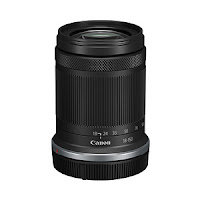Canon Europe has announced details of a new branch for the EOS family tree, specifically for the EOS R mirrorless camera system. Encompassing newly developed APS-C sensors – which are around 62% of the size of full frame sensors – the EOS R7 and EOS R10 cameras offer two entry points for amateur and enthusiast photographers, as well as content creators, to take advantage of the technology and benefits of the EOS R system.
Also launched at the same time are two new lenses, designed specifically for the APS-C format. The RF-S lens line-up starts with two kit lenses – the RF-S 18-45mm f4.5-6.3 IS STM and the RF-S 18-150mm f3.5-6.3 IS STM. The smaller image circle created by the RF-S lenses matches the smaller size of the APS-C sensor, whilst still promising excellent image quality as well as optical performance.
EOS R7
If you're familiar with Canon camera naming convention, then you'll know the heritage of this camera. With a clear nod towards the EOS 7D-series of DSLRs, renowned for their fast-shooting capability for wildlife and action photography, the EOS R7 can shoot at 15 frames per second (fps) using the mechanical shutter, increasing to 30 fps with the electronic shutter – matching the performance of the flagship full frame EOS R3 camera.
There are further advanced features which have trickled down from the EOS R7's bigger and older siblings. Notably, the EOS R7 boasts IBIS – in-body image stabilisation – which opens up additional creative possibilities when shooting handheld. It can shoot 4K video, and Canon Log 3 is available too.
The EOS R7 is earmarked as the flagship APS-C sized R-series camera and will sit at the top of this new branch of mirrorless cameras.
EOS R10
Canon describes the EOS R10 as 'a powerful all-rounder'. Positioned roughly between where the EOS 90D and EOS 850D (Rebel T8i) sit in the DSLR line-up, it's an advanced amateur camera. Whilst is doesn't have the IBIS of the EOS R7, it still offers the incredible focusing prowess of recent R-series cameras, with subject detection for people, animals and vehicles, as well as useful focusing presets known as Case settings.
It's small – think along the lines of the EOS 250D (Rebel SL2), matching perfectly with the more compact RF-S lenses.
In common with most amateur and enthusiast level EOS cameras, the EOS R10 has a built-in flash. There are Special Scene (SCN) modes too, useful to get you started with specific subjects, including a new Panoramic mode which can stitch panoramas in-camera for you (also on the new EOS R7).
Packing a punch
Both models inherit the key focusing features that have propelled the EOS R system's development since its launch in 2018. The Deep Learning technology of the subject detection system is included, offering tracking for people, animals and vehicles. There are four Case settings – predefined focusing profiles for different types of moving subjects – as well as the default Auto Case setting.
The hotshoe is also the latest type – a multi-function socket which was first seen on the EOS R3 and which works with Canon's latest accessories which can draw their power from the camera itself, without needing a separate power source.
Canon states that bringing the APS-C sensor format to the EOS R system is all about giving 'freedom of choice'. It also brings a new lower price point for entry to the EOS R system and, combined with the smaller, more affordable RF-S lenses, means that more photographers may now feel that there's a viable 'upgrade' path. EF and EF-S lenses are also compatible with the EOS R7 and R10 – via an adapter which will be included free in-box initially. Canon guarantees no loss of performance when using an adapted EF or EF-S lens over when used on one its DSLRs.
Lens line-up
The two new RF-S lenses are small, compact and lightweight. Their compact nature is aided by the retractable lens design, which enables the length to be reduced when storing.
 |
 One of the bugbears of the DSLR APS-C line-up was that EF-S lenses were only compatible with APS-C model cameras. Upgrading to full frame would potentially mean a huge shift in lens ownership. With the RF mount, Canon has overcome this obstacle. The RF mount can natively accept both RF and RF-S lenses; likewise the new RF-S lenses will be compatible with other cameras in the EOS R-series line-up, with cameras compensating for the smaller image circle by automatically switching to crop mode.
One of the bugbears of the DSLR APS-C line-up was that EF-S lenses were only compatible with APS-C model cameras. Upgrading to full frame would potentially mean a huge shift in lens ownership. With the RF mount, Canon has overcome this obstacle. The RF mount can natively accept both RF and RF-S lenses; likewise the new RF-S lenses will be compatible with other cameras in the EOS R-series line-up, with cameras compensating for the smaller image circle by automatically switching to crop mode.The EOS R7 and EOS R10 cameras, plus the RF-S 18-45mm f4.5-6.3 IS STM and RF-S 18-150mm f3.5-6.3 IS STM lenses, are expected to be available from 23 June (EOS R7) and in July. The lenses will be available separately as well as supplied as a kit with the new cameras.
For more information, press release and full specifications, visit the system section – click on the links below.
- EOS R7 camera – £1349.99 RRP
- EOS R10 camera – £899.99 RRP
- RF-S 18-45mm f4.5-6.3 IS STM – £319.99 RRP
- RF-S 18-150mm f3.5-6.3 IS STM – £519.99 RRP



